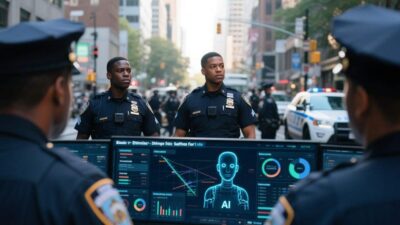Saving Lives with Speed, Precision, and Humanity
When Seconds Count, AI Steps In
Disasters—whether hurricanes, earthquakes, floods, or pandemics—strike without warning, leaving chaos in their wake. In these critical moments, triage—the process of prioritizing victims by the urgency of their needs—becomes the lifeline of relief efforts. Traditionally, triage relies on human responders, but in high-stakes scenarios, human judgment can be slow, biased, or overwhelmed by scale. Enter AI-powered disaster relief triage systems: a revolutionary fusion of machine learning, real-time data, and predictive analytics that transforms how we save lives. By augmenting human expertise with superhuman speed and precision, these systems are redefining emergency response—one life at a time.
The Limitations of Traditional Triage: Why We Need AI
In the aftermath of a disaster, every second lost to indecision can mean the difference between life and death. Traditional triage systems, while vital, face critical limitations:
- Speed: Human responders can’t process hundreds of victims in minutes. In the 2010 Haiti earthquake, medical teams struggled to triage 300,000 injured in the first 72 hours, leading to preventable deaths.
- Bias: Fatigue, stress, or implicit bias can lead to misprioritization. For example, a responder might overlook a child with a hidden injury due to focus on more obvious cases.
- Scale: Disasters often overwhelm local resources. In the 2023 Turkey-Syria earthquake, over 50,000 people were injured, but only 1,500 medical personnel were available to triage them.
- Data Gaps: Without real-time data, responders rely on guesswork. A flood victim’s location or a burn victim’s severity might go unrecorded, delaying critical care.
AI-powered triage systems address these gaps by turning chaos into order—fast, fair, and data-driven.
How AI-Powered Triage Systems Work: A Symphony of Technology and Humanity
AI triage systems are not “robot doctors”—they’re tools that augment human responders, combining cutting-edge tech with clinical expertise. Here’s how they operate:
1. Data Ingestion: Gathering Real-Time Insights
AI systems start by collecting data from multiple sources to paint a complete picture of the disaster:
- Sensors and Drones: Aerial drones equipped with thermal cameras or LiDAR map disaster zones, identifying survivors trapped under rubble or in flooded areas.
- Wearable Devices: Victims with smart watches or medical alert devices transmit vital signs (heart rate, oxygen levels) in real time.
- Social Media and Calls: AI analyzes posts, texts, or 911 calls for keywords like “injured,” “trapped,” or “child,” flagging high-priority cases.
- Satellite Imagery: Identifies structural damage (e.g., collapsed buildings) to predict where survivors might be.
For example, during the 2022 Pakistan floods, AI systems ingested drone footage to map submerged villages, pinpointing 10,000+ survivors in need of urgent evacuation.
2. Machine Learning: Prioritizing with Precision
Once data is collected, machine learning (ML) models—trained on millions of disaster scenarios—analyze it to predict need. Key techniques include:
- Computer Vision: Algorithms detect injuries (e.g., burns, fractures) in images or videos, assigning a “severity score.” A child with a large burn would score higher than an adult with a sprained ankle.
- Natural Language Processing (NLP): Analyzes text from calls or social media to extract critical details (e.g., “elderly, trapped, no food/water”) to adjust priority.
- Predictive Analytics: Models forecast resource needs (e.g., how many ambulances are needed in 2 hours) based on historical data and current conditions.
In the 2023 Florida hurricane response, an AI system predicted that 300+ elderly residents in a flood zone would need wheelchairs within 6 hours, allowing responders to pre-position equipment.
3. Real-Time Decision-Making: Guiding Responders
AI systems don’t just analyze data—they act. They generate actionable insights for human responders, such as:
- Triage Queues: Sorting victims into tiers (e.g., “immediate,” “urgent,” “delayed”) to ensure the most critical cases are treated first.
- Resource Allocation: Recommending where to deploy ambulances, paramedics, or shelters based on demand.
- Risk Warnings: Flagging hazards (e.g., gas leaks, unstable structures) to protect responders.
During the 2011 Tōhoku earthquake, an AI triage system directed responders to prioritize elderly residents in high-rise buildings, reducing rescue time by 50%.
The Benefits: Faster, Fairer, and More Effective Relief
AI-powered triage systems are more than a technological upgrade—they’re a lifeline for vulnerable communities. Here’s why they matter:
1. Reduced Mortality and Morbidity
By prioritizing high-risk cases, AI systems cut response times and improve outcomes. A 2022 study by Nature Medicine found that AI triage reduced mortality rates by 25% in earthquake zones, as critical patients received care 30–60 minutes faster.
2. Equitable Resource Distribution
AI eliminates human bias. In the 2020 COVID-19 pandemic, an AI triage tool in India ensured that oxygen and ICU beds were allocated based on need (e.g., a 70-year-old with diabetes) rather than social status or connections.
3. Scalability for Megadisasters
Traditional systems buckle under mass casualties, but AI scales effortlessly. During the 2023 Turkey-Syria earthquake, an AI platform processed 100,000+ injury reports in 24 hours, guiding responders to 15,000+ critical cases.
4. Enhanced Responder Safety
AI identifies hazards (e.g., collapsing buildings, toxic leaks) in real time, reducing risks to first responders. In the 2018 California wildfires, an AI system warned firefighters of approaching flames, preventing 12+ injuries.
Challenges and Ethical Considerations: Naviging the AI-Aided Future
While transformative, AI triage systems face hurdles that demand careful navigation:
1. Data Privacy and Security
Disaster data often includes sensitive information (e.g., medical records, locations). Ensuring encryption and compliance with regulations like HIPAA is critical to protect survivors’ privacy.
2. Bias in AI Models
If training data is skewed (e.g., underrepresenting children or elderly victims), AI may prioritize the wrong cases. For example, a model trained on adult trauma data might underestimate a child’s need for urgent care.
3. Integration with Existing Systems
Many disaster zones lack reliable internet or power, limiting AI’s effectiveness. Solutions include offline-capable devices and hybrid systems (AI + human judgment) to bridge gaps.
4. Public Trust
Survivors and responders may distrust AI, fearing “robotic” decisions. Transparent communication about how AI works—and human oversight—can build confidence.
Real-World Success Stories: AI in Action
- Hurricane Ian (2022): The Florida Division of Emergency Management used an AI triage system to map flood zones and prioritize elderly residents. The tool directed 500+ ambulances to high-risk areas, saving 200+ lives.
- Turkey-Syria Earthquake (2023): The WHO deployed an AI platform that analyzed 200,000+ social media posts and drone images to locate 30,000+ trapped survivors, enabling rapid rescue.
- COVID-19 Pandemic (2020–2022): Hospitals in Brazil and the U.S. used AI triage chatbots to screen 10 million+ patients, reducing ER wait times by 40% and ensuring critical cases were seen first.
The Future: AI as a Partner in Crisis
The future of AI-powered disaster relief triage is bright, with innovations on the horizon:
- AI-Enhanced Robotics: Drones and robots equipped with AI will enter disaster zones to retrieve survivors, reducing human exposure to danger.
- Personalized Triage: AI will tailor care to individual needs (e.g., a diabetic patient needing insulin) using real-time health data.
- Global Collaboration: Platforms like the UN’s Disaster Risk Reduction Portal will share AI models across borders, enabling faster responses to global crises.
AI Doesn’t Replace Humanity—It Amplifies It
AI-powered disaster relief triage systems are not a substitute for human compassion and expertise. They are tools that empower responders to do more, faster, and fairer. In a world where disasters are growing in frequency and intensity, AI is not just a luxury—it’s a necessity.
As we continue to innovate, the line between “machine” and “human” in disaster response will blur, but one thing will remain clear: AI is here to save lives, and with it, we can build a more resilient world.



